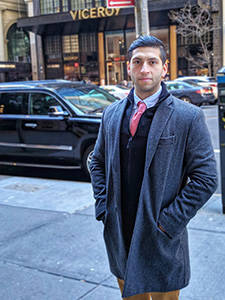Arman Gill, MD
COVID-19 and Radiology Resident Education: What Now?
 Since the beginning of the pandemic in March 2020, radiology programs across the world have adapted to the circumstances. With unprecedented times and limited guidance, institutions handled these situations differently.
Since the beginning of the pandemic in March 2020, radiology programs across the world have adapted to the circumstances. With unprecedented times and limited guidance, institutions handled these situations differently. Now as the pandemic draws to an end, hospitals are settling into what should be their new normal. This article shares a resident’s first-hand perspective on the pandemic’s impact on radiology training and responds to the Academic Radiology article: "The Impact of the COVID-19 Pandemic on Radiology Resident Education: Where Do We Go From Here?” For reference, I am one of 20 residents participating in an 800-bed community hospital residency program in Florida.
Readouts
Resident-attending readouts serve as the foundation for learning in any radiology residency program. Traditionally, these readouts were done in person, typically with an attending physician and a resident physician sharing a workspace.With the hybrid work-from-home and in-person model in place, some attending physicians are physically in the reading room while others read from home. Specific accommodations are provided to ensure the needs are met for both attendings and residents. For attendings who choose to work in person, readouts have returned to pre-pandemic style. My program currently uses Microsoft Teams as a form of communication within the program. This allows us to communicate via text and voice/video call whether working from home or in person.
When comparing the two models, my preference is in person. Although screen sharing and instantaneous voice calls allow for efficient communication, I feel the learning is superior in person. While reading from home, instructors are sometimes unable to gauge body language and visual cues from trainees. From a trainee perspective, I feel that this is not the case. The biggest advantage for in-person readouts and communication is the quick back and forth discussions and questions that don’t translate well over a virtual medium. Furthermore, I feel more engaged and motivated with someone beside me going through a lesson.
Although not directly related to readouts, the virtual model creates unnecessary barriers to communication, in my opinion. Although the attending physicians are very open, encouraging residents to reach out whenever we have a question, my experience is the extra steps create hesitancy.
For some programs, the volume of readouts decreased because of the pandemic and certain studies are not being ordered by ordering providers. This is certainly not the case at my institution as volume within the department has grown to above pre-pandemic levels. I will not speculate as to why this is occurring, but the breadth of pathology and volume of cases is certainly not an issue.
Teaching Rounds
Teaching rounds and conferences throughout the hospital have largely changed to a hybrid model. In many of the formal graduate medical education sessions, radiology has a limited role and typically only a select group of residents attend, as these events are typically geared toward other subspecialties.Although not a formal teaching event, the radiology department plays a prominent role in the weekly tumor board conferences. In these conferences, the resident on the corresponding service is expected to prepare relevant imaging for each case. Prior to the pandemic, these conferences took place in a large conference room and now occur over Zoom. The biggest advantage to this setup is that showing imaging is more efficient from our own workstation where we can access the PACS without issue, which leads to more efficient preparation and allows us to troubleshoot quickly.
However, the disadvantage is the lack of connection to consultants within the hospital system. Even though meetings through Zoom are more efficient, the small talk and the greetings exchanged during these meetings is invaluable in fostering relationships and ultimately lost in the current format.
Virtual Learning and Flipped Classroom Model
The pandemic issued in an era of virtual learning with remote educational conferences and lectures. In the early days of the pandemic, daily didactic lectures were predominately online-only to encourage social distancing. As time passed, efforts were made to make more of these conferences in person, and in fact, the majority occur with the speaker in person. From a resident perspective, I find a higher level of information retention during in-person meetings as well as higher resident participation.A welcome change is the increase in remote lectures by outside institutions. Throughout the pandemic, many outside institutions recorded their lectures and allowed access to lectures by leaders in their fields over the internet. These lectures cover topics not commonly seen during our day-to-day rotations and will only increase our breadth of knowledge in residency and careers.
Mentorship, Career Planning and Resident Research
Mentorship and career planning was not affected by the pandemic. The attending physicians are always willing to share their knowledge and help in any way.Organizing research opportunities is now more efficient in the post-pandemic era. With the use of Microsoft Teams, it’s easier to create groups for research projects and for staff to share potential ideas. This allows for quick and easy postings, and lessens the need to wait for scheduled meetings to share ideas.